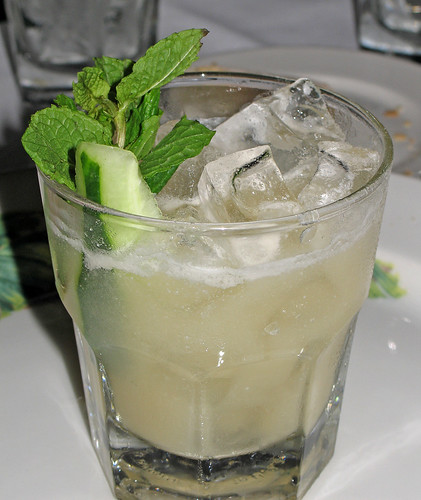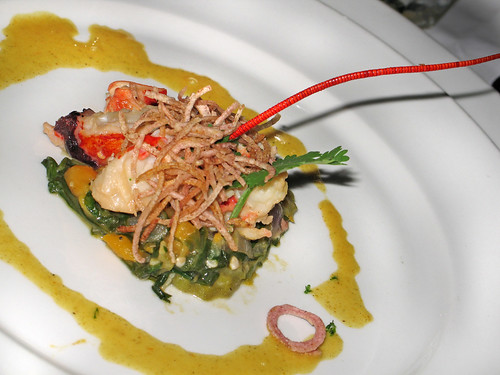Looking through the Tales of the Cocktail listing this year yet another seminar caught my eye — Vermouth, conducted by Dr. Cocktail, Martin Doudoroff (his partner in CocktailDB) and Erica Duecy of Fodor’s. I was keenly interested in attending this seminar as I am a born-again vermouth drinker. Yes, a long time ago I used to fear vermouth, not unlike how I used to fear gin. As my interest in fine and classic cocktails began to develop, and I began collecting and studying old cocktail books, I quickly realized that I wasn’t going to get very far if I kept eliminating cocktails that contained gin or vermouth.
Quick lesson — vermouth is a fortified, aromatized white wine (even the red vermouth comes from a white wine base) in three main flavors — dry (or French), bianco (sweet white) and red (sweet, or Italian). The word vermouth itself comes from the German “wermut” which means … wormwood. That’s one of the bitter herbs used (or at least once used) in the making of this herb-infused wine, used initially as an aperitif and a tonic and as a way to mask the flavor of cheap white wine. Over the years it found its way into myriad cocktails due to its great flexibility as an ingredient.
I finally came into the world of vermouth via Italian / red / sweet vermouth, whichever appellation you prefer, about 8 years ago, and via the Manhattan, which quickly became one of my favorite cocktails. From there I made my way through countless classics, then to the Vermouth Cocktail itself (consisting solely of vermouth, bitters and grenadine) and eventually on to the summit of Mount Everest for those who quest to overcome a fear of gin and vermouth — the classic Martini, 2:1 (although I prefer a 5:1 proportion myself).
Unfortuately my keenness to attend this seminar didn’t keep me from being grievously late for it (we kept running into people we knew along the way), but we did get to taste a few things and hear about the Big Vermouth News — that Noilly Prat, maker of what’s probably the best dry vermouth in the mass market (“and that’s swill,” says Martin, which doesn’t say much for the rest of it), is reformulating its vermouth to go back to their old 1856 recipe, which will be spicier, more herbal, perhaps even a bit more bitter, and will perhaps change the face of Martini drinking. Sadly they managed not to get their promised samples to them in time for the seminar, but apparently we can expect to see this stuff everywhere before too much longer. [2009 update: The new product is now called Noilly Prat Original Dry, and it’s great stuff.]
Perhaps the most important lesson one can take from this seminar is this — unless you are a bar with high volume or you swill a lot of Martinis every day, buy white / dry vermouth IN SMALL BOTTLES 9375ml), and KEEP IT IN THE REFRIGERATOR. Even better, every time you open it spray in some of that inert wine preserver gas befoer you seal it up again. This stuff is wine, and wine goes bad; even fortified wines go bad eventually. The shelf life of white vermouth is a MAXIMUM of six months, maybe a year for the red in the fridge. I think one of the reason a lot of people say they hate vermouth in their Martinis is because someone’s made them a Martini using a bottle of cheap dry vermouth that’s been in the cabinet or bar for years and years and gets used a few drops at a time. The stuff went bad during the first Clinton adminstration, and you expect to be able to make a decent drink with it? Write a six-months-from-now expiration date on the label with a Sharpie, keep it in the fridge, and if you don’t use it up by then throw it away and buy more — it’s cheap.
One nice goodie we got at the seminar was a handout (yay, I love handouts!) of interesting things being done with vermouth at some top bars and restaurants these days. I’d be pleased to share those with you. Let’s start with this one.
Eve
House Apéritif, The Pegu Club, NYC
Created by Audrey Saunders
A 1-liter bottle Noilly Prat Original Dry vermouth.
8 Macintosh apples.
1 crab apple.
Slice the apples thin on a mandolin.
Pour vermouth over the apples until they’re submerged. Cover and refrigerate for 5 days, agitating the mixture a little bit each day.
Strain mixture back into the Noilly Prat bottle.
Serve a four-ounce pour, well-chilled, in a coupe glass (kind of a large Champagne saucer). For garnish, float a thin slice of crab apple over the drink.
This sounds fantastic, but I fear I might have a hard time finding one of the ingredients. Where, outside of Orr’s cheeks, am I going to find crab apples? Farmers’ markets, here I come — they’ll be in season during the fall.








